Tech Bindings for Steep Skiing
 Monday, March 20, 2017 at 09:16PM
Monday, March 20, 2017 at 09:16PM 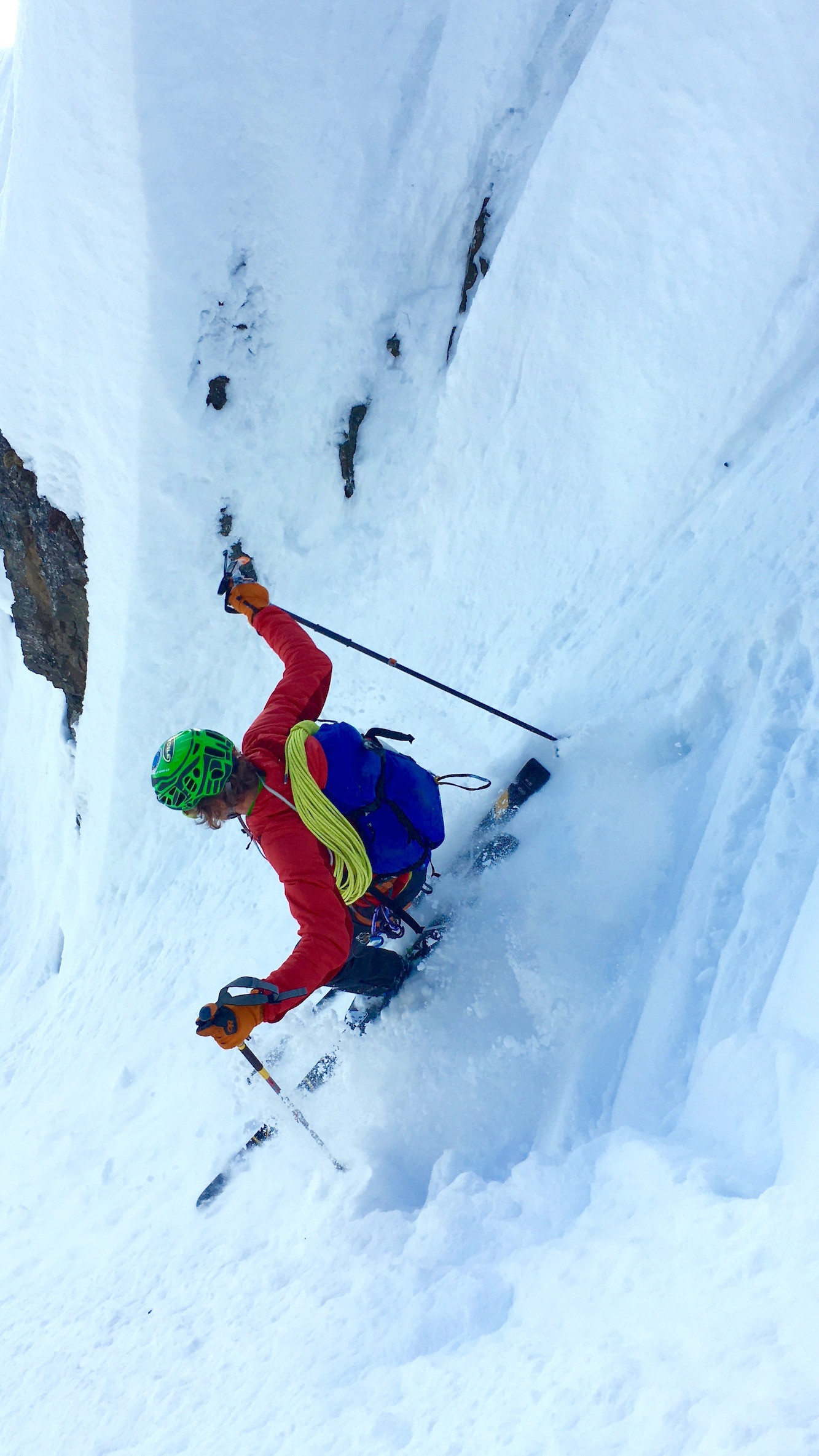 No time to be worrying about your bindingsI guess it's time to end the silence on these pages. Funny how the blog-scape has changed with the times. It seems that peoples' attention spans have shortened and now folks gravitate toward short hits of adventure and related gear stories. I'm guilty of gravitating to Instagram myself. But ideas continue to percolate in my brain and I'm finally feeling motivated enough to share some thoughts. Hell, it costs me $15/month just to have this site active so I might as well contribute. Hopefully, someone is still reading.
No time to be worrying about your bindingsI guess it's time to end the silence on these pages. Funny how the blog-scape has changed with the times. It seems that peoples' attention spans have shortened and now folks gravitate toward short hits of adventure and related gear stories. I'm guilty of gravitating to Instagram myself. But ideas continue to percolate in my brain and I'm finally feeling motivated enough to share some thoughts. Hell, it costs me $15/month just to have this site active so I might as well contribute. Hopefully, someone is still reading.
Any readers that have followed me on Instagram (https://www.instagram.com/brian.skimolife/?hl=en) have noticed my favoritism toward steep skiing. While a good portion of the backcountry skiing community seeks out fresh, untracked powder as their preferred distraction, my partners and I deviate from the herd, looking for more obscure, hard to get to, sometimes unskied lines that might scare us more often than not. This is a problem, I'll admit. But our motto is, "...position over conditions every time!". It's true. Given a choice between a lovely field of 25 degree stable blower pow or a choked-off, rocky, styrofoam-floored couloir high on some creepy, cold North face...well, you know where you'll find us.
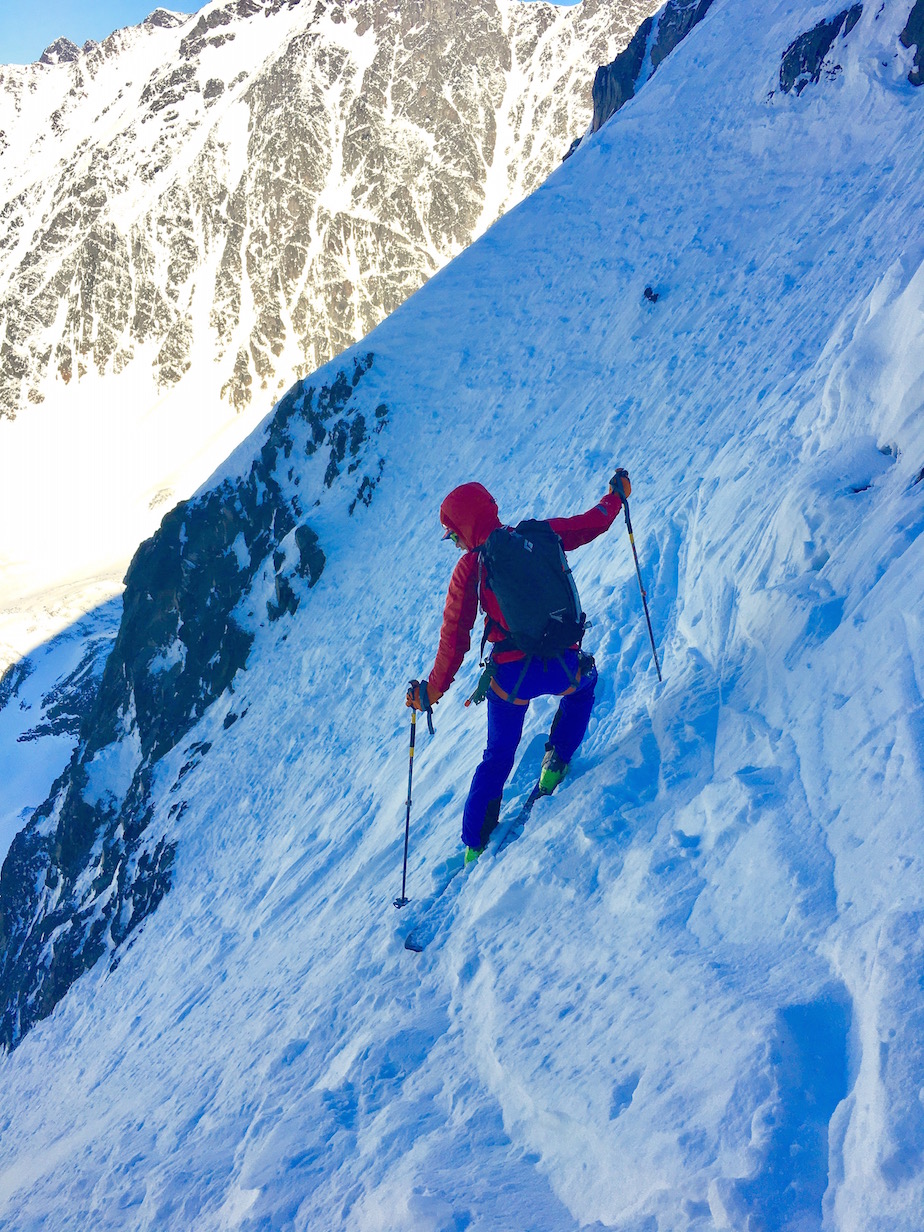 Mat Brunton contemplating the next turnThere's not a lot of ripping huge turns going on in our world a good deal of the time. It's one-turn-at-a-time, often jumping into the air between each, poking the surface, holding our breaths wondering if the whole thing might rip. Each airborn change of direction and brief loss of contact with the surface creates an instant opportunity for disaster. With each successful landing comes the addicting rush of another disaster averted. But honestly, we sniff around a lot, sometimes on belay, so we have a good idea that conditions will permit a descent. Caution nearly always prevails since any sort of misstep in these places would lead to some sort of epic or worse.
Mat Brunton contemplating the next turnThere's not a lot of ripping huge turns going on in our world a good deal of the time. It's one-turn-at-a-time, often jumping into the air between each, poking the surface, holding our breaths wondering if the whole thing might rip. Each airborn change of direction and brief loss of contact with the surface creates an instant opportunity for disaster. With each successful landing comes the addicting rush of another disaster averted. But honestly, we sniff around a lot, sometimes on belay, so we have a good idea that conditions will permit a descent. Caution nearly always prevails since any sort of misstep in these places would lead to some sort of epic or worse.
Playing this game requires a combination of physical, mental and material preparation. Truth be told, steep skiing is performed everyday with a variety of ski mountaineering gear. Big boots, race boots, light skis, heavy skis, platform bindings, race bindings all do the trick. But for me and my ilk, lighter gear nearly always prevails. Why ski one great line when you can ski two or three in a single outing? That kind of volume obsession generally requires gear that will allow us to travel farther with less energy. Heavy shit simply won't cover it.
Gear failure is not an option, either. Of course, I realize equipment breaks all the time. Not just light stuff but ALL gear. We play the odds, for sure. But we try to play the odds with equipment that has a strong pedigree and durability testing that reduces the risk. Race bindings, for instance, get severely hammered in skimo race competitions and the stress of one-turn-at-a-time ski alpinism pales in comparison. The simplicity of these bindings systems actually makes them more reliable and less prone to failure. For instance, there are far more failures of widely adjustable, multi-featured heel pieces than the simpler race heel designs found on all my skis.
As skimo racing has grown, so, too, have the race binding choices. Shops like Skimo Co in Salt Lake City have made huge strides in bringing this gear to North America. When I first started, the only way to get your hands on the trickest offerings from Europe was to shop there. Oh, how times have changed. The increase in choices has allowed me, for better or worse, to diversify my binding quiver... just because. I'll admit it. I'm a gear geek. I'm a guy with enough disposable income to do this silliness while secretly hoping to find the key to making me a better skier (I'm still looking...).
My ski quiver now sports four different brands of bindings and an additional generation or two of at least one brand. I committed early to race bindings for all my skiing and have no plans on changing that. Honestly, I fail to see any reason why most skiers don't lean in the same direction given the reduction in weight that these systems offer. And while some would argue that these bindings are somehow less "safe" than more complicated models, testing of many of the race models suggests otherwise. The bottom line is you can blow your knee on any kind of binding and people do everyday. Your best bet is to ski smart, under control and come into the season with some strong-ass legs. But I digress...
So, what I'll do here is talk about the bindings I have and use and what I think of them. Remember, this is a blog and these are my OPINIONS. Nothing more. You may find someone blathering on like this with a different opinion. Take both with a grain of salt and use these points of view to help you with your own decisions. But, ultimately, it's your decision to make. Commit and accept your fate.
Characteristics
What am I looking for in a binding? First, I want something that will do the job, ie. hold my boots firmly to my skis. The connection has to be solid and reliable. Some tech bindings do this more obviously than others. Over the years, I've seen seemingly identical mechanisms behave very differently when I finally step into the binding. This likely has to do with the springs involved and the subtle differnences in the engineering and design. Some toe piece designs tolerate ice better than others, for instance. The width of the boot toes and the varying spacing of the tech inserts in them from brand to brand also impacts this characteristic. What looks the same may be different in subtle ways. Often, the only way to discover these nuances is to ski them. I've done some of the leg work for you.
Next, I want something that's light. I've covered this above but weight matters. Lately, I've given up a few grams in order to capitalize on some of these other points. Pick your poison.
Third, durability matters. If a toe piece wing snaps in the middle of a hop turn on a firm, 50 degree slope you could die. Period. Or, your binding could break in a less critical position but you're left 10 miles in with only one ski. Problematic, to say the least. So, I want gear that will fail as infrequently as possible. My choices these days center around either known issues or my own biased perceptions of potential issues.
Last is the issue of release. This is a hot topic for many and I get it. A blown knee is a huge bummer. As an orthopedic physician assistant, I've seen this hundreds of times and have followed patients through rehab more times than I can count. Some skiers may think that heavily featured bindings are safer but I'm not convinced that's true. Release testing of a multitude of race bindings by the folks at Skimo Co using the Montana Jetbond device have revealed that the simple race bindings release in predictable fashion and often have lower DIN values than the featured choices. Bottom line here is that skiing is dangerous but you don't necessarily give up safety when you give up weight. Likely the most important thing to do to increase your safety is to unlock your toes when descending. But that's a whole other discussion.
My Brands
Although Dynafit dominated the tech binding market as the original innovator for around a decade and half, expiration of the patent in the mid 2000's led to several European machine shops jumping into the tech binding market. This increased competition led to innovation. Plum, originally a maker of cams and motorcycle machine parts, decided to get into the binding business in 2007 as the owner's son was a skimo racer. Located just west of Chamonix in the Haute-Savoie region of France, the company enjoyed an enthusiastic following of both Euro and North American skiers. They expanded their line but maintained their position as makers of light and reliable bindings. Truth be told, some of their more relaxed touring models had some durability issues but they failed to appear in the race line up. I adopted them early on with only one issue where my lost ski slammed into the side of a rock wall and sheared off a toe wing. Other than that, I trust my life to them.
Intitially, the Race toes (86 grams) went into "lock" mode when you stepped in but alterations of the rules for skimo racing has led to a requirement for a "release" mode in all bindings. Plum Race 145 in original "auto lock" modePlum has followed suit, something undoubtedly attractive to many non-racing ski mountaineers.
Manually releasing the toe when exiting the binding requires some significant force, more than Dynafit but not as much as Kreuzspitze.
Plum was one of the first to offer a heel piece with an adjustment plate (Race 170) so that boot sole length differences could be accounted for on the same pair of skis up to 10mm. This is a nice feature shared by other brands. The way each binding fixes this length varies. Some use an adjustment screw (Trab Gara) while others use either 2 or 4 screws holding down the heel piece. Plum uses two. I prefer four. Some Thread Lock can eliminate some of the issue with the screws loosening. The height of the heel piece on the 170 is lower than the standard race heel in order to keep the ramp minimal (delta=2.5mm).
Plum has refused to expand their production numbers, keeping quality high while continuing to tweek design and durability. They're still used by many steep skiers, particularly in the Chamonix region of the alps.
These guys are another small Italian machine shop making quality tech bindings. I'm a big fan of their 4 screw adjustable heel plate. I like it better than the Plum Race 170 which features only two screws. Of late, I've been a little frustrated by the performance of the toe piece in my current choice of boot, the Arcterx Procline, noticing a hestitancy of the pins to snap in place with step in. This has vexed me to the point that I have drilled an extra set of inserts in my skis so that I can use Dynafit Speed toes instead (see below). Luckily, two of the holes are shared between models.
The Kreuzspitze SCTT toe (78 grams) features a beautifully machined crampon receptical that is without peer. The aftermarket adjustment plates allow for 14-40mm of adjustment between three different size plates. These plates put the ramp delta at 5mm. Like Plum, this toe requires some force to release manually when exiting and the lever lacks a nice receptor for the ski pole tip found on the Dynafit.
Just to try something different this year, I bought a pair of Trab Gara Titan Adjustable (78 grams with plate) bindings for use on a new pair of Movement skis. The spring mechanism of the toes is unique in that the lever in front is actually part of the spring retention mechanism of the pins. As such, the lever must be held down while putting your toe in with pin holes properly aligned. This creates a slightly different kind of fiddle that's easily mastered. The absence of springs under the wings eliminates a common point of icing that can create retention issues in other brands. Nice touch. On the other hand, the tour mode/full lock out of the toes requires a firm snap of the somewhat flexible plastic lever. I don't know if they break but it feels a little sketchy to me each time I yank on it. Additionally, the lever is impossibly difficult to "unsnap" and I've taken to using my ski pole to knock it unlocked. This is awkward when transition space is tight. As a result, it's unlikely I'll use these bindings on outings where such situations are likely to be encountered.
The ramp is several millimeters higher on the Trabs (delta=7mm) due to the taller heel piece. Not a deal breaker but noticeable compared to the other two above. The single adjustment screw of the heel allows for 28mm of fore/aft freedom. The ski crampon receptor is a little tight and requires some tweeking initially, at least with my B & D Ski Gear crampons.
Finally, the company that started the tech binding revolution. I started out with several models of Dynafit bindings years ago but drifted away from the brand when I was racing and other brands came on line that were simply better in ways I was seeking. Dynafit rose to the challenge of a competitive market with equal amounts of success and failure. But one product which I consider a raging success is the Speed Radical toe piece (145 grams). Its time-tested design has seen few failures and subtle improvements like the toe stops (photo) which aid in stepping in are true innovations. I'm willing to give up about 50 grams per toe piece compared to the others. The sturdy nature and ease of operation are worth it. The crampon receptor is elegant. The front toe lever is positive while not being overly stiff to operate.
Hybrid is the Answer
My favorite binding is actually a hybrid of the Dynafit Speed toe and either the Kreuzspitze or Plum adjustable heels. This gives me confidence boosting toe fixation with ease of entry and the simplicity and adjustability of a race heel. It's true that these race heels lack a high rise position for steep skin tracks but, really, it just motivates me and my ilk to put in sensibly pitched skinners for all to enjoy. Arm waxing is for idiots and 20-somethings!
 Brian |
Brian |  23 Comments |
23 Comments |  Dynafit,
Dynafit,  Kreuzspitze,
Kreuzspitze,  Plum,
Plum,  steep skiing in
steep skiing in  Gear
Gear 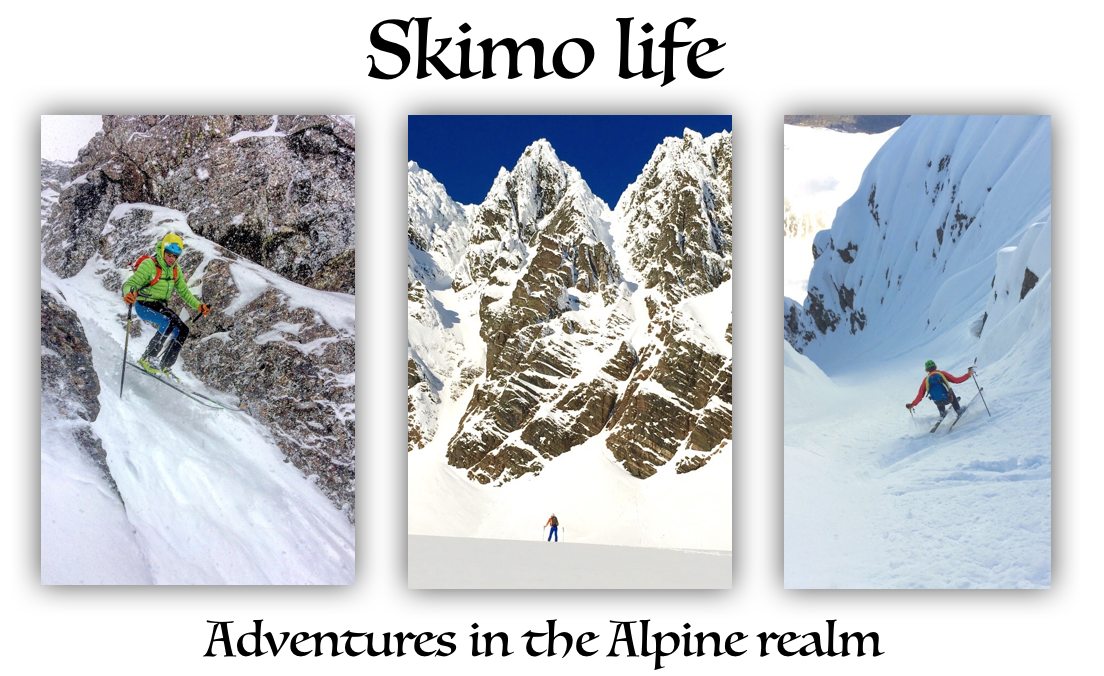



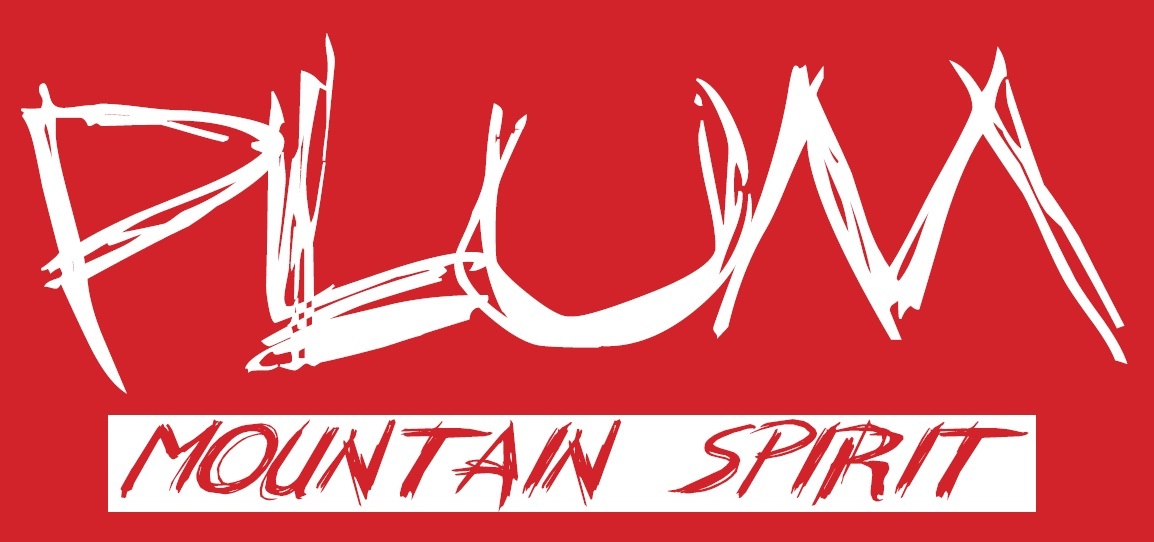
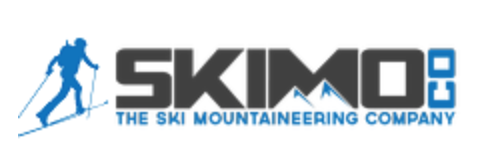



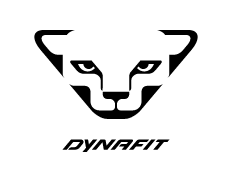
Reader Comments (23)
Brian, good post and glad to hear from you again on here. I was starting to think maybe you'd been injured, caught by the Anchorage serial killer, or even worse...gotten yourself into a long-term relationship with someone who forbade you to ski.
It seems I've independently gravitated to a lot of the same gear you like. I'm a big fan of the Dynafit toe-piece and the Kreuzespitze adjustable heel piece combo. Was also thinking of going to the Procline but wanted to wait and see how it stood up to abuse before I spent $1K. So after a season of abusing the Proclines would you still say you trust your life to them, how much slop do they have (wear rate normal?), and as stiff as your TLT6s? Thanks...I know that's an off topic question but I trust your input. -Josh
Great post, I really appreciate your clear, experience-backed, no-nonsense style of writing.
I have the Trab Titans, Plum 170s, and Dyna LTR's. Dynafits are my least favorite...toe piece is the toughest to reliably line up and click into, heel piece sticks, toe lever doesn't have a convenient indentation/catch for sticking the ski pole tip into for releasing (I've tired semi-successfully to remedy this with a couple wraps of duct tape). I'm really liking the Plums, least issues with them. I honestly find the Titans to be the easiest toe to click into because of having to manually hold the spring open; should be even easier when I have a pair of the new LS RaceBorgs next season with the little slot guides on the toe of the boot. The plastic lever on the Titan's is a bit annoying...would it have been that much heavier to use aluminum? After a season of use the bottom of the lever has worn/rounded enough that it doesn't reliably lock-out. I've wrapped a couple layers of duct tape on to make them stickier. This seems like the opposite problem from what you describe---I've never had a problem unlocking this lever.
Josh,
That's pretty funny. Thanks for hanging around. No, Instagram sort of stole my mojo. Typical of the times, I guess, with shortening attention spans and all that unfortunate shit. I think it's good for my brain to write so I'll try to get back on the regular posting.
As for the Proclines, I'll do a post soon on them. For what it's worth, I'm going to something else next year. That should give you some indication of my overall impression. But I'll be more specific when I write. Stay tuned.
Tony,
Thanks for piping up. Inspires me to keep at it. Cheers for that.
Interesting how our experiences with the bindings differ. I really wonder what the deal is with the Trabs and my boots. Aside from the plastic toe lever, they're a brilliant design. I'm really curious why I struggle with unlocking the lever. Seriously, my palms were trashed and bruised after the first couple of efforts and I switched to using the handle of my ski pole to knock it free. It takes significant force which sounds quite a bit different from your experience. I suspect it has something to do with the distance between toe tech fittings. I'm also disappointed to hear about the plastic wearing out. I hadn't considered that. My biggest worry remains the lever actually snapping since it takes so much force to lock and unlock it. Curious.
As for the Dynafit super light toe that you have...I have not used it but my partners have. There is a little indent for the pole on the lever in the current version. I'm curious what your's have. Karol over locked her's once and it was quite an epic getting it free. She simply pulled too hard and it inverted. Almost cut short a brilliant day.
Obviously, the Dynafit Speed toe addresses most of the issues you bring up but, given your leanings toward really light race gear, you may not want to take on the extra 50 grams, or so. At one time I would have had the same aversion. But given the terrain I seek out lately, reliability and predictable operation is paramount.
I just finished reading every post, after discovering your blog earlier this year. I found your posts very informative as well as inspirational, as I'm an aging mountaineer looking to add more skiing to my trips. Thanks for paying the $15/month!
You successfully captured my attention beyond the 1min time limit of IG videos. Bravo!
Enrique,
Thanks for saying as much. I'm glad all these words continue to serve some purpose for others. Ultimately, that's what it's all about. Cheers.
Glad you're back, as I've learned a lot from this place over the years. Couple questions:
Do you know anything about/have any experience with the Movement race binding?
And speaking of Movement, I think you use some of their skis.Any thoughts on Big Fish vs Alp Trax 84 for spring ski mountaineering in the Sierra and Cascades? Or recommendations for a similar ski for that purpose?
Thanks again. Cheers!
Hey Dave,
Thanks for hanging in there while I got my shit back together.
Funny you should ask about Movement. You're right. I use them and have a growing quiver now. I'll likely add another at the beginning of next season to bring the total to 4 pairs. My next post should be on those skis. However, I'll answer your specific question now.
First, I have no experience with the binding. It looks sweet and the features seem cool. It's also extraordinarily light. But, as you've noticed, I've added a little weight to my bindings, at least in the toe, in order to beef up the (perceived?) reliability and ease of access. They're likely one of many excellent choices for race bindings. That niche is getting very competitive and saturated. Good problem to have. Jason at Skimo Co can dig into it further for you, I'm sure.
As for the skis, the best all-around ski I have is the Movement Vertex X 84. Such a great ski. It can do it all from hard steeps to blower powder. It's always quite surprising the way it excels in such a variety of conditions. I have it in a 177cm and I'm 6' 170 lbs.
I also have the Big Fish in a 168 cm. Another great ski. I love it in the short length for long-range missions. I ski it with a Dynafit PDG. The Big Fish is a stiff, fully cambered firm snow shredding weapon. Very snappy. Tails are stiff so don't get into the back seat. Slight early rise so it does a pretty good in variable crap. Obviously, not a great tool for powder but that's not why you have it. Holds an edge perfectly on bullet proof, refrozen spring couloirs. The short length and extremely light weight makes whipping it around in tight, steep terrain very confidence inspiring. It would be my choice for big spring NW volcano missions or long Eastern Sierra corn harvesting.
The third ski I have is the Alp Tracks 100 in a 177 cm. Silly light powder ski that can also hold an edge when the wind board shows up on the windward side of a ridge. It's much stiffer than my other powder ski, the DPS Tour 1 Wailer. It's not as fun as the DPS but also more reliable on firmness and seems to have a higher speed limit than the Tour 1. The shape is said to be the same as the Vertex but the construction is different and drops a few grams. I haven't felt the 84 yet but my guess is that it's a little stiffer than the Vertex. Both would be awesome choices for what you are doing. I would say both the Vertex and the Alp Tracks would be more versatile than the Big Fish.
The missing piece to my quiver is going to be the Alp Tracks 90 cm. I'm pretty sure I'll get it in a 169 cm. I love short skis for long skimo days where technical terrain is guaranteed and you'll likely have the skis on your back part of the time. I'm curious to see how a little more girth underfoot affects performance. Might have to sell my Vertex.
One other thing about Movement...they seem to exceedingly durable. I've nailed some rocks this season and without fail, I cringe at the transition, turning them over for inspection expecting to find a core shot and there's hardly a scratch. Quite surprising and awesome.
Hope that helps.
Thanks for the detailed reply Brian. Super helpful, but maybe irresponsibly so - I may have to get both the Big Fish and the Vertex 84! I'll definitely be in touch with Jason at Skimo.
Cheers!
Ah, this post reminds me of the good old days, trying to figure out all this gear over the internet with the assistance of blogs like this!
Sadly, Skimo Co now takes all the mystery out of it...
A few comments though:
"Some use an adjustment screw [...] while others use either 2 or 4 screws holding down the heel piece. Plum uses two. I prefer four."
I've been using many Plum 165/170 heels for many years.
Even with some occasional adjustments for boot swapping, never had any inadvertent loosening.
And still zero slop.
"My favorite binding is actually a hybrid of the Dynafit Speed toe and either the Kreuzspitze or Plum adjustable heels. This gives me confidence boosting toe fixation with ease of entry and the simplicity and adjustability of a race heel. It's true that these race heels lack a high rise position for steep skin tracks but, really, it just motivates me and my ilk to put in sensibly pitched skinners for all to enjoy. Arm waxing is for idiots and 20-somethings!"
I've mounted many such setups for many folks, and the even better part is that thanks to Skimo Co this is actually the least-expensive Tech-style binding available (less so than event the Speed Turn).
Plus if you really want a higher elevator position, both K and Plum offer an after-market accessory that inserts into the U-shape at the back of the heel fork, then you turn the binding 180 degrees for the higher position.
re Dynafit toe lever intent, that same toe has been available with three different levers.
The LTR 1.0 Auto metal toe lever isn't very pole friendly.
Manual version would seem to be pole friendly (although I also use my hand).
I've mounted the LTR 2.0 Auto, which has a plastic lever, but I can't remember how well it would seem to work with a ski pole tip.
re Movement race binding, same rebranded ATK generation as the Hagan ZR:
http://skimo.co/hagan-zr-binding#tab-review
re Movement Big Fish-X, I'm a big fan:
http://skimo.co/movement-big-fish-x#tab-review
Thanks, Jonathan. We used to do a lot more of this back in the day, didn't we? You're right, though, Jason does a fine job of it. I only do it because more opinions are better than less and hopefully, the information we put out there helps someone get to where they're going. And then there's the vanity of just putting our opinions in print. I'm guilty of that, too.
I'm glad you added to your observations here. You certainly have always given lots of thought into the gear we use and abuse.
Movement review on the way....
Hi brian, nice post and interesting blog! Just a quick question. When I first starting using Dynafits (Speed radicals) I had a couple of bad experiences with the toe pieces releasing due to ice in my boot toe inserts, luckily on 'no-consequence' terrain. Due to those experiences I am now a bit paranoid and ALWAYS carry a swiss army knife with me and give the inserts a little scrape before clicking in - which is easier said than done when on a 50 deg slope. Just wondering if you do anything similar or have any other checks to make sure you're properly clicked in before skiing steep stuff?
Brian,
Great posts, inspiring blog, and the Instagram migration works for me. Some nice dicey stuff you frequent. Thanks for keeping us desk jockeys energized.
My Movement Vertex have seen some topsheet damage. Basically a flapper the width of 2 matchsticks Use them a fair amount side and backcountry, but nonetheless it's something a full sidewall ski likely would not see. No biggie, epoxy filled, duct tape (thanks Jason@skimo.co) and good to go. Did good duty in Wasatch, Northeast and Cham.
I have not enjoyed Jonathan's experience with the 2 screw Plum Guide adjustment plate. Mine have shifted several times. I'm likely to move to locktite next season, which I note Plum includes in their nice little repair/maintenance kit. Jason correctly points out that this can be an issue, but even after tightening mine down the night before, they came loose by the end of the Crochues-Berard, a very moderate tour (but with some consequences if you blow the initial traverse.) I think this is clearly an issue, but still like the Plumb fit and finish, and the brakes are great. I have these as well as TLT lights and decade + old Speed Turns, and the last is the oldest and most consistent on step in and release.
Thom,
Thanks for chiming in. You may have more days on your skis than me. Honestly, I don't have a hint of delam anywhere on mine yet but I mix up my quiver use all season which spreads the load a bit. Perhaps a one off for you. Doesn't sound like a deal breaker, anyway.
As for the Plum bindings, mine have moved a few times, like you suggest. The thing I don't like is that I really feel like I have to crank the screws down. I bought a long-handle torx driver specifically for the job and a couple of longer bits for my repair kit that make it easier in the field if they loosen. I still worry about stripping them, though. I think the Kreuzspitze plate fix is simply a better design with 4 screws although it would be better with bigger screws. The torx size is one size down from the Plums.
Ola,
Yeah, that experience sucks and is one that I fear every time I step in. The newer Dynafit pins have a little edge on them that allows you the "scrape" the inside of your inserts by sliding the ski forward and backward before stepping into the heel. That nearly always does the trick for me. This is easy to do on a steep ledge on the slope of your run. I visually inspect the penetration of the pins into the fittings, as well. And lastly, I attempt to lock the bindings into "tour" mode. The lever should come up as usual which is pretty easily. If there is resistance, I check for ice and go through the step in ritual again. I don't ski with locked toes as much these days so this process gets even more of my attention. Even still, locking the toe is no guarantee that an iced-up pin/binding interface will hold, anyway.
Great post Brian - I'm totally on board with race bindings - this winter I'll be using ATK Revolutions after dropping down from their Raider 2.0. I also have some Plums so I can mix and match if need be. Does the Plum 170 heel cut it for steep icy descents? No problem with rotating out of the heel insert?
Dan,
I've found over the years that the only people who think race bindings aren't up to the task have never used race bindings. These skiers either think they're too gnar or too fat. I suppose there could be a weight limit on these models but if you are treading anywhere near that line you need to get your diet in order and quit eating like shit! As for the gnar zone, perhaps if you like to huck off cliffs and land switch, the DIN 7 might be a bit soft.
But for the rest of us ski alpinists, I've rarely had any issue with releasing from tech style race bindings. The only way for the heel to "rotate out" as you asked, is for a nearly simultaneous release from the toe piece. Without that, the heel will remain secure. And although they look insignificant, race heels are magnificently elegant creations, distillations of exactly what a skier needs without extraneous bullshit.
It's a very dangerous but exciting game.
Brian:
I've been thinking a lot about binding combos lately and thought I would do some thinking out loud here to add to the conversation.
My race binding for the last few years has been the Dynafit LTR 2.0 (pink and grey with the plastic Gignoux heel pieces). These are great for racing and most "touring" but having seen a few of the heel pieces self destruct, I'm hesitant to ski them anywhere with more serious consequence.
For proper ski alpinism, I've tried a few combinations of the following bindings:
Dynafit LTR 1.0
Dynafit LTR 2.0
Dynafit Expedition/Speed
Plum 170 (old and new)
I love the idea and simplicity of the Expedition heel though all my boots are different BSL so the fact that it's not adjustable is definitely a bummer. As well, the mounting is absolutely horrendous as the holes are too close to the heel and it's not possible to fit a screwdriver straight up and down so you screw in at an angle. I'm never worried about releasing though!
The Speed toe that is paired with the expedition is in my opinion, the gold standard. Relatively light, easy to use, easy to mount, bomber.
The LTR2 heel, as I mentioned is not useful but I was hoping the toe would be a good replacement for the Speed toe as it's lighter and feels just as secure. Unfortunately I've twice had the black plastic piece snap beyond the normal locking position and become stuck. The only way I was able to get out of the binding was to stomp it as hard as possible with my free boot. Unfortunately, both times, this resulted in the plastic bit exploding and then no longer having the ability to lock. That makes these toes pretty suspect to me.
I've got the old Plum 170 toes and after seeing another pair crack, have retired them. The adjustable heels however are my absolute favorite. Easy to mount, durable, simple, and still pretty light! My only complaint, as yours, is the high torque needed for the adjustment screws. I've never had one slip but I have cracked them down tight and periodically replace the screw heads as I start to strip them out.
I recently bought a new pair of the 170s for my GF and they have a redesigned toe piece with a better lock mechanism. I'm curious if these would be a good way to drop weight from the Speed toe but avoid the unreliability of the LTR 2.0 toe.
Currently my preferred setup is a Speed Toe with a Plum 170 heel. I'm hoping that the new Plum toe will help lighten this up a bit while staying equally reliable.
My only other temptation is that the only negative you mentioned about the adjustable Trab binding being the ramp (doesn't bother me). The adjustability on those looks incredibly simple and way less risk of stripping a screw head or losing a part in the field. Maybe a Speed toe with the Trab heel?
Keep the posts coming Brian!